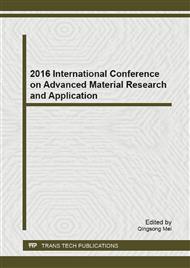[1]
A.S. Chandran, S.K. Narayanankutty, Polyaniline-Coated Short Nylon Fiber/Natural Rubber Conducting Composite, Polym. Plast. Technol., 50 (2011) 443-452.
DOI: 10.1080/03602559.2010.543225
Google Scholar
[2]
J. Chang, A. Ho, W.K. Chin, Behaviors of the positive temperature coefficient of resistance of poly(styrene-co-n-butylacrylate) filled with Ni-plated core-shell polymeric particles, J. Polym. Sci. Pol. Phys, 45 (2007) 322-329.
DOI: 10.1002/polb.21028
Google Scholar
[3]
S.O. Pongdhorn, S. Chakrit, T. Uthai, H. Kannika, Comparison of reinforcing efficiency between Si-69 and Si-264 in a conventional vulcanization system, Polym. Test, 23 (2004) 871-879.
DOI: 10.1016/j.polymertesting.2004.05.008
Google Scholar
[4]
P. Annadurai, A.K. Mallick, D.K. Tripathy, Studies on microwave shielding materials based on ferrite- and carbon black-filled EPDM rubber in the X-band frequency, J. Appl. Polym. Sci., 83 (2002) 145-150.
DOI: 10.1002/app.2237
Google Scholar
[5]
S. Araby, I. Zaman, Q.S. Meng, N. Kawashima, A. Michelmore, H.C. Kuan, P. Majewski, J. Ma, L.Q. Zhang, Melt compounding with graphene to develop functional, high-performance elastomers, Nanotech., 24 (2013).
DOI: 10.1088/0957-4484/24/16/165601
Google Scholar
[6]
T. Araki, J.L. White, Shear viscosity of rubber modified thermoplastics: Dynamically vulcanized thermoplastic elastomers and ABS resins at very low stress, Polym. Eng. Sci., 38 (1998) 590-595.
DOI: 10.1002/pen.10222
Google Scholar
[7]
Y.T. Vu, J.E. Mark, L.H. Pham, M. Engelhardt, Clay nanolayer reinforcement of cis-1, 4-polyisoprene and epoxidized natural rubber J. Appl. Polym. Sci., 82 (2001) 1391-1403.
DOI: 10.1002/app.1976
Google Scholar
[8]
J. Su, S.J. Chen, J. Zhang, Z.Z. Xu, Combined effect of VA content and pH level of filler on properties of EPDM/SmBO3 and EPDM/ATO composites reinforced by three types of EVA, J. Appl. Polym. Sci., 117 (2009) 1741-1749.
DOI: 10.1002/app.32106
Google Scholar
[9]
J. Su, S.J. Chen, J. Zhang, Reinforcement of EPDM/SmBO3 and EPDM/ATO composites by four polyolefins: assessment of branch content and crystallinit, J. Elastom. Plast, 42 (2010) 471-492.
DOI: 10.1177/0095244310379980
Google Scholar
[10]
S. Lemanceau, G. Bertrand-Chadeyron, R. Mahiou, M. El-Ghozzi, J.C. Cousseins, P. Conflant, R.N. Vannier, Synthesis and Characterization of H-LnBO3 Orthoborates (Ln 5La, Nd, Sm, and Eu), J. Solid State Chem., 148 (1999) 229-235.
DOI: 10.1006/jssc.1999.8437
Google Scholar
[11]
M. Balasubramanian, M.A. Paglicawan, Z.X. Zhang, S.H. Lee, Z.X. Xin, J.K. Kim, Prediction and optimization of mechanical properties of polypropylene/waste tire powder blends using a hybrid Artificial Neural Network-Genetic Algorithm (GA-ANN), J. Thermoplast. Compos, 21 (2008).
DOI: 10.1177/0892705707084543
Google Scholar
[12]
A. Bani, G. Polacco, G. Gallone, Microwave-Induced Devulcanization for Poly(ethylene-propylene-diene) Recycling, J. Appl. Polym. Sci, 120 (2011) 2904-2911.
DOI: 10.1002/app.33359
Google Scholar
[13]
B. Bartelsen, K. Bokamp, G. Rockendorf, N. Vennemann, Development of an elastomeric material based on EPDM for the use in thermal solar collectors, Kaut Gum. Kuns., 50 (1997) 766.
Google Scholar
[14]
G.C. Basak, A. Bandyopadhyay, A.K. Bhowmick, Influence of nanoclay on adhesion of EPDM vulcanizate, Int. J. Adhes. Adhes, 31 (2011) 209-219.
DOI: 10.1016/j.ijadhadh.2011.02.001
Google Scholar
[15]
M.A. Bashir, N. Iqbal, M. Shahid, Quratulain, R. Ahmed, Structural, Viscoelastic, and Vulcanization Study of Sponge Ethylene-Propylene-Diene Monomer Composites with Various Carbon Black Loadings, J. Appl. Polym. Sci, 131 (2014).
DOI: 10.1002/app.39423
Google Scholar
[16]
C. Bi, M.F. Zhu, Q.H. Zhang, Y.G. Li, H.Z. Wang, Preparation and Properties of Electromagnetic Wave Absorption Materials BaTiO3/MWCNT and Derived PAN Hybrid Fibers, J. Inorg. Mater, 25 (2010) 829-834.
DOI: 10.3724/sp.j.1077.2010.00829
Google Scholar
[17]
M. Muasher, M. Sain, The efficacy of photostabilizers on the color change of wood filled plastic composites, Polym. Degrad. Stab, 91 (2006) 1156-1165.
DOI: 10.1016/j.polymdegradstab.2005.06.024
Google Scholar


